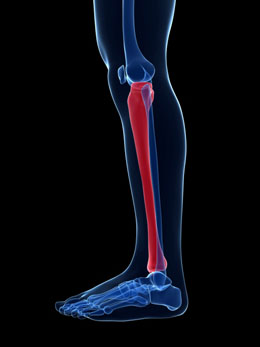Osteosarcoma is the most common form of primary bone cancer. The article provides information regarding a patient's prognosis (chance of recovery) depending upon the stage of cancer.

Osteosarcoma is a cancer that begins in the bones, and sometimes metastasizes (spreads) to other parts of the body (usually lungs or bones). It usually develops from the osteoblasts (the cells from which the bone develops). More than 400 cases of osteosarcoma are registered every year in the US. This cancer arises due to unpredictable errors in the DNA of osteoblasts, and is more common in men than women. However, it is a form of childhood cancer, and cases of osteosarcoma in adults are very rare.
Symptoms
The most common symptoms are pain and swelling in the bones of legs or arms. The pain mostly occurs in the longer bones of the body parts. The pain or swelling lasts for several weeks, and the child may also develop an unexplained limp. In some cases, the bones in the arms or legs might break or fracture easily, since the cancer weakens them.
Treatment
Chemotherapy or medications are used to kill the cancer cells and shrink the tumor. This may be followed by surgery, to remove the remaining cancerous cells or tumor. Post surgery, chemotherapy might be employed to kill any remaining cancer cells so as to minimize the recurrence of the cancer. In severe cases, surgical treatments are advised which include amputation, or limb salvage surgery.
In osteosarcoma involving an arm or leg, doctors advise a limb salvage surgery rather than an amputation. In this surgery, the infected bone and muscles are removed,and the empty gap is filled either by a bone graft, or a special metal prosthesis (artificial replacement of a part of the body). For adults, cancer control drugs such as cisplatin, doxorubicin, carboplatin, and ifosfamide might be prescribed.
Prognosis
The term 'prognosis' refers to what doctors think are the chances of recovery for a patient, or the possibility of the recurrence of cancer. This depends on many factors, which vary from one patient to another. They are:
- The patient's age and overall health
- The location and size of the tumor
- Results of the tests performed
- Stage of the osteosarcoma (how abnormal the cells look)
- Whether the cancer is localized or metastatic (spread), or recurrent
- Extent to which the cancer could be removed by surgery
- Response to the treatment
- Whether lung metastases can be removed with surgery (resectable).
Doctors cannot be absolutely certain about a patient's prognosis, as the outcome can vary from patient to patient. As per research studies, survival rates of 60% to 80% are possible for osteosarcoma that hasn't spread beyond the tumor. This again depends upon the patient's response to chemotherapy. Also, a patient with the cancer in the arm or leg, generally has a better prognosis than the one whose disease involves the pelvic bones, shoulder blades, spine, or ribs.
With recent advancements in medicine, the chances of survival have increased. The survival rate depends upon the success of chemotherapy and the body's response to the drugs.
Disclaimer:
This Buzzle article is for informative purposes only, and should not be used as a replacement for expert medical advice.


 Osteosarcoma is a cancer that begins in the bones, and sometimes metastasizes (spreads) to other parts of the body (usually lungs or bones). It usually develops from the osteoblasts (the cells from which the bone develops). More than 400 cases of osteosarcoma are registered every year in the US. This cancer arises due to unpredictable errors in the DNA of osteoblasts, and is more common in men than women. However, it is a form of childhood cancer, and cases of osteosarcoma in adults are very rare.
Osteosarcoma is a cancer that begins in the bones, and sometimes metastasizes (spreads) to other parts of the body (usually lungs or bones). It usually develops from the osteoblasts (the cells from which the bone develops). More than 400 cases of osteosarcoma are registered every year in the US. This cancer arises due to unpredictable errors in the DNA of osteoblasts, and is more common in men than women. However, it is a form of childhood cancer, and cases of osteosarcoma in adults are very rare.